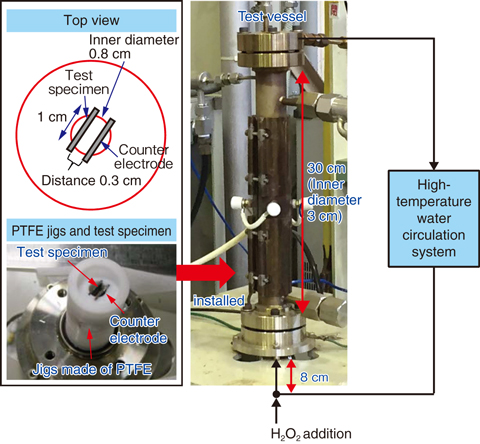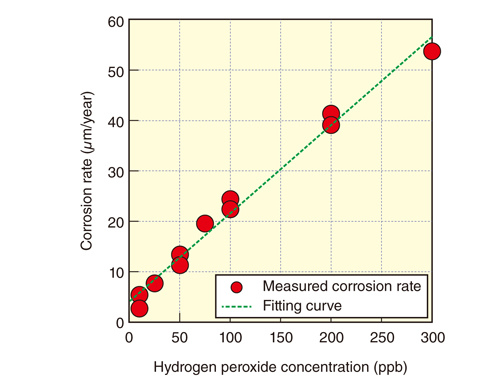
Fig.4-7 Electrochemical-test vessel

Fig.4-8 The relationship between the corrosion rate determined by the resistance measurements and the hydrogen peroxide concentration
Degradation of materials owing to corrosion (e.g., stress corrosion cracking) is a major problem in boiling water reactors (BWRs). Electrochemical measurement in simulated BWR cooling-water conditions is a major approach to understand the mechanism of corrosion. The cooling water in a BWR is pure light water with high temperature (288°C) and high pressure (70 atm). Hydrogen peroxide (H2O2), which has high oxidizability, is generated owing to irradiation. The hot pure water has a high electric resistance, while H2O2 decomposes easily at high temperature (it disappears after approximately 1 min) and this decomposition is further enhanced by contact with the surfaces of the metals. Thus, electrochemical measurements in simulated BWR conditions are difficult to perform. Therefore, we developed a system to measure electrochemical data under such conditions.
A test vessel designed to maintain high pressure is shown in Fig.4-7. High-temperature water flows into the test vessel in which the vessel specimen was installed for electrochemical examinations. The high electric resistance of water caused a potential drop in the water when the current flowed. To reduce this drop, we minimized the path of current flow between the test specimen and the counter electrode to a distance of 0.3 cm. To prevent the disappearance of H2O2 through decomposition, we performed the measurements as quickly as possible after the H2O2 was added to the test specimen. We also minimized the distance between the addition point of the H2O2 and the test vessel to approximately 8 cm as well as the volume of the test vessel. To prevent the decomposition of H2O2 at the vessel surface, we installed jigs composed of polytetrafluoroethylene (PTFE), in which the decomposition was much smaller than that of the metals. These enabled us to obtain the electrochemical data with greater precision in simulated BWR conditions.
The measurements of the impedances, which are electrochemical parameters, were performed. The impedances were measured by supplying a sinusoidal AC voltage between two stainless-steel specimens installed inside the vessel. The impedances corresponding to the conductivity, the composition, and the thickness of the oxide film as well as the corrosion rate could be measured by changing the frequency of the supplied AC voltages. Obtained impedances were inversely proportional to the current that flowed at the surface of the stainless steel, which was proportional to the stainless steel’s corrosion rate. Therefore, the corrosion rate could be determined by measurements of the impedances. The obtained stainless-steel corrosion rates are shown in Fig.4-8 alongside H2O2 concentrations; we confirmed that the two quantities were proportional. This is expected to be important information in understanding the mechanism of degradation due to the corrosion. Moreover, we will improve this electrochemical test equipment such that it can be applied to the measurements of other electrochemical parameters.